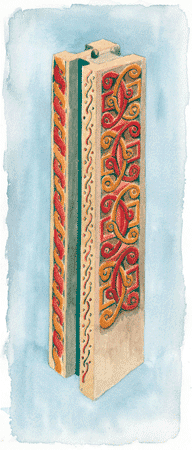- Home
- The town and the abbey
- The site from its origins
- Early history
- A pillar from the tomb's chancel
The tomb of the martyred saint must have drawn many of the faithful. According to Grégoire de Tours, the tomb was in the form of a raised sarcophagus, the peaked cover of which was draped in a cloth set with gold, precious stones and pearls. A chancel pillar appears to have come from a structure that was built to protect the tomb from the crowds of pilgrims. It was discovered in 1947, re-used in the foundation of an extension of the Merovingian basilica. Large rabbets were cut into the side of the square pillar for holding panels that were part of a 90-cm-high enclosure. Two of the pillar's faces are sculpted in low relief and painted in red and yellow ocher. The decorative repertoire includes a rare interlace pattern, similar to the decoration seen on certain fibulas found in the sixth-century necropolis.
Proposed reconstruction of the pillar with the fragment of a second pillar and part of a chancel panel, also found at Saint-Denis; 6th century. © UASD / J.-P Marie,M. Wyss.
Reconstructed view of the polychrome of the chancel pillar assumed to be from the 6th century. © UASD / M. Wyss.


